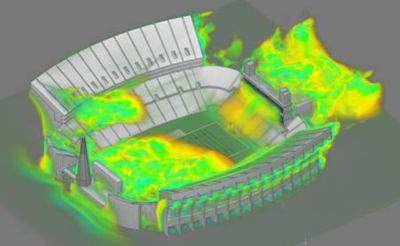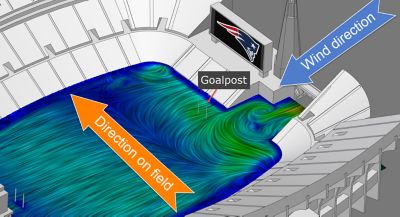-
-
Access Free Student Software
Ansys empowers the next generation of engineers
Students get free access to world-class simulation software.
-
Connect with Ansys Now!
Design your future
Connect with Ansys to explore how simulation can power your next breakthrough.
Countries & Regions
Free Trials
Products & Services
Learn
About
Back
Products & Services
Back
Learn
Ansys empowers the next generation of engineers
Students get free access to world-class simulation software.
Back
About
Design your future
Connect with Ansys to explore how simulation can power your next breakthrough.
Free Trials
ANSYS BLOG
February 3, 2018
Can The Patriots Get an Edge with Real time CFD Simulation?
I think I figured it out. The Patriots might be using real-time CFD simulation to raise their field goal percentages.
As anyone who watches the NFL knows, the Patriots are perennial winners. With their third Super Bowl appearance in the last four years, it seems they have an automatic ticket to the big game.
However, all six of their appearances in the last 14 years have been close, coming down to 4 or fewer points. A single missed field goal could have sent the Lombardi trophy to a different team.
Fortunately for the Patriots, their kicking game is top notch. New England has finished in the top 5 in made field goal percentage in 4 of the last 5 years, with a league best 94.6% made field goals in 2014. Is this because they only attempt conservative kicks, or play in a closed stadium? In fact, it is quite the opposite.
With an outdoor home stadium located in chilly New England, one would expect weather to have a significant negative impact on field goal attempts. Snow, ice, or a large wind gust should make it more difficult to convert a field goal. It certainly does for the Patriots’ opponents. New England’s competition finished near the bottom of the league in made field goal percentage in 4 of the last 5 years.
So then how do the Patriots account for this large discrepancy? They must have an advantage, and I believe that advantage could be Ansys.
Using computational fluid dynamics (CFD), it is possible to analyze the airflow in and around a football stadium for certain conditions. Given inputs of wind direction and speed coming towards the stadium, a complete model of airflow behavior throughout the stadium can be generated and visualized. With this information a player or coach could make critical decisions about whether to attempt a long field goal, or which direction to compensate for wind swirling effects near the field. Understanding this invisible airflow behavior can make the difference between making or missing the game winning kick.
Unfortunately, traditional CFD simulation typically takes hours on large computers to produce a meaningful, highly accurate, result. For a player on the field, this is much too long to wait and makes the use of CFD simulation impractical for airflow prediction. The ideal solution would be to collect information about wind speed and direction just before the crucial kick and calculate the flow pattern instantaneously on a laptop on the sideline.
Thanks to Ansys Discovery, a breakthrough in real-time CFD simulation from Ansys, this instantaneous prediction from current conditions is now possible. Let me illustrate.
Here you can see just how easy it is to take a model of an entire football stadium, select a wind direction, and immediately visualize the full 3D airflow behavior. If the wind changes, simply introduce a new direction or speed to instantaneously see the new flow pattern.
Perhaps you are wondering, why simulate airflow at all? Why not look at the direction the flag is blowing and kick in the other? Let’s look at the real-time CFD simulation results in Discovery Live to answer this question. Here is the flow behavior within Gillette Stadium with the wind blowing lengthwise along the field. I am using a 2D direction plot to interactively visualize the velocity of the flow near the field, where it matters most. I expect to see wind direction within the stadium roughly matching the incoming airflow direction. When I look at the results, however, it is obvious that this is not the case.
This is the ‘kicker’. Even though the flag might be blowing in one direction, you want to kick as if it is blowing in a very different direction. How intuitive is that? If the Patriots are not using real-time CFD simulation already, I would be more than happy to show them — or any other
team in the NFL — just how easy it is to predict local airflow from the sideline with Ansys Discovery. In fact, you can even try this simulation or something similar for yourself. Just get a trial copy of Ansys Discovery and start simulating in minutes. The possibilities are endless.
Let’s go Pats!


